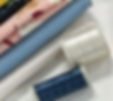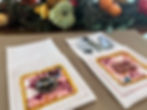No Hassle Sewing Canvas, Needle Punch Fabric using Sewing Machine & DIY Flatware Pocket Tutorial
- Heidi Proffetty
- Oct 2, 2023
- 4 min read
Make these pretty canvas fabric flatware pockets that can be customized for any special event or regular use. Learn tips for sewing canvas without hassles and how to use your sewing machine to needle punch cloth creating perforations for perfectly aligned hand stitching when working with heavier threads or embroidery floss, and add the finishing touch with thread-wrapped buttons. These flatware pockets will add a lovely touch to your holiday table arrangement. Best of all you only need an afternoon and a few supplies, such as canvas fabric, novelty and linen accent fabric scraps, embroidery floss, and buttons.



First things first, this design should fit most standard silverware sizes, but it never hurts to break out the measuring tape and make any changes to the pattern if needed.
It's also a good idea to know some tips when sewing canvas with our home sewing machines. Since canvas is a heavier fabric, your going to need to use a specific thread and needle for the sewing machine in addition to making several machine adjustments.

For this project we are working with a medium weight canvas which is similar to medium weight denim, a 40-weight cotton, polyester, or cotton-wrapped polyester thread will most likely be your best selection.

There’s no such thing as one needle that works for every type of sewing project. As with any thicker fabric, sewing canvas requires a stronger needle, one that has a stronger shank and a pointy, slightly rounded tip that can penetrate the fabric without bending, deflecting or breaking is essential. The eye of the needle also needs to accommodate the thickness of your thread. Jeans needles in sizes 90/14 or Janome's purple tip needles, are two nice choices.

My sewing machine has automatic tension, which means it has built-in sensors that detect the thickness of the fabric and adjust the foot pressure automatically. If your machine does not offer an automated tension option, you may need to adjust the tension manually. Heavier threads and materials require significantly less tension, letting your fabric feed more smoothly through the machine. If your machine is having trouble feeding your fabric, the presser foot is probably pushing down on the fabric too hard, preventing the feed dogs from feeding the fabric. By reducing the presser foot pressure, you are releasing the feed dogs and letting them do their job.
Because you are sewing through many layers of fabric, a walking foot is key. A walking foot evenly feeds your top and bottom layer of fabrics.

I'm using a Janome Continental M7 sewing machine, which has a special system for uniformly feeding fabric from the top and bottom. It's called the AcuFeed Flex feeding system. Used with the HP2 foot, which has excellent visibility and is ideal for precise topstitching. It firmly holds the fabrics in sync with the feed dogs. It’s paired up with the Professional Grade (HP) straight stitch needle plate. By combining these sewing components, I am able to achieve perfect, professional looking topstitch results.

A hump jumper (a button shank foot) or even a wedge of folded fabric can become your new best buddy in no time. It balances your presser foot when your start to sew those first few stitches of thicker layers of fabric or when approaching a thicker seam. Because the front of the presser foot is already lifted when you start stitching thick material, you'll want to place the hump jumper beneath the rear of the presser foot to level it from front to back. This will guarantee that you don’t get stopped or locked up as you take those first initial few stitches while also keeping the fabric moving underneath the foot.


Canvas is a tightly woven, heavier cotton fabric; therefore, a somewhat longer straight stitch length is needed. A stitch length of 3.0 to 3.5 can help keep the material moving without stopping the foot and stitching in one spot, as well as give you a nicer, more professional-looking finish.
After you've set up your sewing machine to sew, don't forget one of the most important steps is to slow the speed of your sewing way down and especially when you take a few back stitches. On some machines, you can adjust the speed manually with your foot controller, or there may be a slider level, dial, or setting on the sewing machine itself to reduce the machine's speed. And, of course, always perform some tests before you dive into making your project.

Pre-washing your canvas can prevent shrinkage and can soften the fabric somewhat, making it a bit easier to work with. Another great tip for storing canvas fabric is to keep it rolled rather than folded to prevent creases.
Keep in mind, that while the simplest method for sewing this project may be stitching together two layers of canvas and turning the material right side out. Clipping and poking out the corners of a thick canvas or even a medium weight fabric can be challenging to produce really nice-looking results. Therefore, I have two recommendations for you: either continue using the canvas and try the technique I describe in the instructions that follow, or swap out the canvas with a lighter more pliable cotton fabric that has been interfaced.
An unconventional but clever use of your sewing machine is to needle punch the fabric without using any thread. To do this, remove your top and bobbin threads, mark where you want the border to be, set your stitch selection to a straight stitch and lengthen the stitch. As you sew along, the needle will punch consistent perforations in the fabric, creating evenly spaced holes. You can then use the holes as your guide to hand embroidered the accent border with thicker threads or embroidery floss. Try this method instead of measuring and marking as you would typically would do for hand embroidery.
How about another creative idea? Create a zig zag or Criss cross pattern for your hand stitched design using the second inner border of stitched perforations.


Here's a look at another project where I used the sewing machine to machine punch the holes to create my accent border.

Here's the link to download my FREE Flatware Pockets tutorial with step-by-step instructions to make and embellish them.
Happy Sewing and Quilting!


